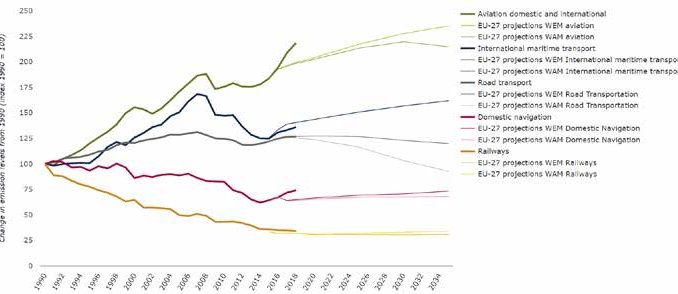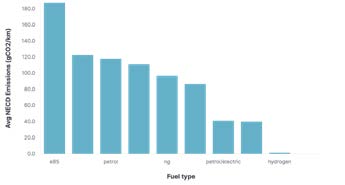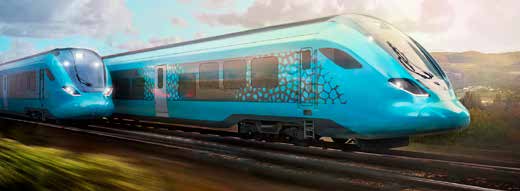Reducing emissions, increasing energy efficiency, implementing widespread use of sustainable fuels, carbon pricing, and other initiatives included in the roadmap that will have to generate a sustainable development of the entire European society – “Fit for 55” are elements with direct impact on the transport system.
by Pamela Luica
The legislative package published in July is a strong and final commitment by the European Commission to achieve its 2050 climate neutral continent target, with proposals for measures and actions by 2030 that would form the basis for what needs to be done in the coming two decades.
Through the Fit for 55 Package, the Commission has declared an open war against the increase in emissions, the key component and starting point for shaping the future of Europe, with everything it entails; covering aspects from how, what and how much we consume, to the creation of new systems and solutions, industry reform, land use, taxation policies and services, the new legislation is the first sign that should deliver clear results in a decade, in accordance with the proposals laid out on the “new paper” for the transformation of the continent.
Since the transport system is the second largest emitter of emissions, accounting for 24.6% of the total emissions in the European Union and is one of the main obstacles to achieving climate goals, the new legislative package directly addresses this issue and puts forward a series of revisions of the legislation in force, but also proposes new measures.
In the period between 2018 and 2019, greenhouse gas emissions coming from transport were not in line with the declining trend of emissions, but on the contrary, increased by 0.8%, without including shipping, following another increase of almost 1 percent recorded in 2018. Although they are the smallest increases since 2014, there are increases and decreases, as they should. The European Environment Agency (EEA) states that according to national estimates, transport emissions will experience a decline by 2030, however the decline would be too low and the level will remain higher than in the 1990s, which causes us to think hard about changing the whole structure and use and about adopting a coherent and comprehensive transformation, otherwise the transport sector will not contribute to reducing emissions and creating a zero- emission economy by 2030 and 2050 respectively.
A totally EU-wide new approach
There was certainly a need for a new legislative framework to remedy the current situation caused by the current measures which, if continued, would result in a 32% increase in emissions by 2030 (compared to 2030).
Thus, a low-emission, revolutionised transport system, focused only on innovative, sustainable, and digitised solutions, products and services is the answer that can contribute to the objectives of the European Green Deal. The Fit for 55 vision is a commitment to transforming the European transport system that should look differently in the next decade: to offer green alternatives to mobility, to rely on electric vehicles supported by a charging infrastructure, to have new emission standards for cars and vans.
By 2030, the policies of the new legislative framework must contribute to reducing emissions by at least 55%, and the transport sector must contribute to the objective, aiming at reducing emissions by 90% by the 2050 horizon. Fit for 55 includes four proposals for sustainable, low- emission mobility, proposals that promote clean vehicles and sustainable fuels.
The revision of CO2 emission standards for new cars and vans aims to reduce the emissions of these types of vehicles and accelerate the development of emission-free transport. According to the plan, the average emissions of new cars should be reduced by 55% from 2030 and by 100% from 2035, compared to the level of 2021, and from 2035 all registered cars will be only zero emissions. According to EEA, the share of electric vans has doubled from 2018 to 2019, reaching 1.4% from 0.8%, but 94% of this type of fleet still uses diesel.

In order for this to happen, infrastructure is needed to meet the demands of the elements set out in the proposal to revise the Alternative Fuels Infrastructure Regulation. In short, the capacity must be appropriate through a network of charging and fuelling points every 60 km for electric vehicles and every 150 km for those running on hydrogen, a hypothesis considered for introducing on motorways.
As the average life of a car is 1-15 years, the proposal covers the need to speed up the pricing of carbon dioxide emissions from road transport so that vehicles are less polluting and CO2 standards will help eliminate cars with emissions and have only zero-emission vehicles. : “We will create a market for sustainable alternative fuels and low-carbon technologies, while putting in place the right infrastructure to ensure the broad uptake of zero- emission vehicles and vessels. This package will take us beyond greening mobility and logistics. It is a chance to make the EU a lead-market for cutting-edge technologies,” Commissioner for Transport, Adina Vălean, said.
In order to complement the ETS (page 14), the EC has proposed the use of sustainable fuels in the aviation and maritime sectors, leading to an increase in the price of polluting fuels for suppliers. As a result, through the ReFuelEU Aviation initiative, fuel suppliers will be forced to increase the use of sustainable fuels by fuelling jet aircraft at European airports and will be encouraged to use e-fuels (synthetic fuels). And because the maritime sector is also targeted, the FuelEU Maritime initiative proposes the use of sustainable fuels and zero-emission technologies for this mode of transport by setting a maximum GHG content limit for the energy used by ships calling at maritime ports.

Fit for 55 states that the emission performance of these sectors can only be ensured if all the factors involved guarantee that new fuels comply with the sustainability criteria for renewable energy sources.
The undisputed rail’s role
The Fit for 55 legislative package does not mention rail transport and it is easy to understand why – it is the cleanest mode of transport of all existing modes and has the ability to constantly revolutionise and can also cause emission reductions. Along with the successes of the railway industry in recent years and its commitment to helping to increase the level of decarbonisation of this mode of transport, the new policies of the European Commission are in its favour with a view to encouraging sustainable transport systems by shifting traffic, the rail and inland waterways being included here. This is the new Strategy for sustainable and smart mobility announced in December 2020 which will guide results over the next four years, with a long-term impact.
Doubling high-speed rail traffic by 2030 and tripling it by 2050, as well as increasing rail freight traffic by 50% in the next decade and doubling it in 2050, are vital components that will build a sustainable transport system in the European Union.
The strategy is a testament to the importance of rail transport in achieving its objectives and providing the necessary transport capacity with a minimal impact on the environment, with prospects to reach zero impact given that the sector is constantly reinventing itself.
The railway transport system produces only 0.4% of the CO2 emissions emitted by the transport sector (road transport has an overwhelming proportion of 72% and air transport contributes 13.2%), and trains are the most efficient transport vehicles, as the level of GHG emissions pkm is only an extremely small portion of most other modes of transport; trains also provide about 8% of European passenger traffic and, in a higher percentage, 19%, it ensures freight traffic. It should be noted that only diesel trains emit emissions, the electric ones being fully in line with what clean mobility means and, in addition, at European level, electricity production is becoming more sustainable, with a declining average of CO2 intensification. For example, between 2000 and 2017, the average CO2 intensity of electricity production decreased by 25%, and if this average is applied to the intensity of electricity consumption of railway transport, GHG emissions from electric rail transport were about 14.4 Mt (in 2018).
While increasing the volume of transport (freight and passengers), the railway sector has managed to reduce its emissions and optimise its energy efficiency, being the only mode of transport that has managed to address the challenges and is now considered a vital component in reducing emissions throughout the transport sector. Viewed in comparison with road transport, the railway energy consumption is six times lower and a journey by rail is 9 times less CO2 intensive. In addition, the efficiency of rail transport has improved in the last five years.
It should be noted that Member States are constantly modernising their railway infrastructure, and the projects include electrification works to reduce the level of emissions caused by diesel trains. But where electrification is not viable from multiple points of view, the industry has the answer: battery, hybrid, or hydrogen trains, which are constantly evolving. Also, more and more states or railway companies are announcing their intention to test and introduce these modern vehicles as an alternative to non-electrified infrastructure and a way to reduce environmental impact and emissions level. The European rail network (EU-27) is 55.6% electrified, with plans to rehabilitate infrastructure including electrification for part of the rest of the lines, and with numerous tenders or contract awards for the purchase of trains running on sustainable fuels and replace diesel propulsion.
Hydrogen train prospects
Hydrogen-based trains operating in Germany and tested in other states (The Netherlands, Austria), with positive results, are starting to be the most sought-after trains, but the companies are not fully prepared in terms of finance and infrastructure to make significant acquisitions. But with new proposals promoting modern and clean transport and encouraging and supporting innovation, these types of trains will become more accessible to operators. In addition, the railway industry is also committed in this respect, with many rolling stock manufacturers announcing their own projects and agreements for the development of hydrogen-based vehicles.
A study presented by FCH JU and S2R JU in 2019, which looks into the opportunities to develop the introduction of fuel cells and hydrogen technology on the railway market, mentions a huge potential of this solution to eliminate diesel trains, reduce costs and deliver efficient, zero-emission and network connected transport services. Obviously, without relying on the new legislative framework of the Commission and having a vague idea of the fantastic acceleration of the concept of sustainability in just two years, the study states that by 2030 one in five trains purchased in Europe could be hydrogen-powered. As the hydrogen fuel solution is mature in the case of multiple units, these vehicles can replace about 30% of diesel trains in the next decade.

The study also states that hydrogen-based trains will be introduced in the first instance on the railway market in Central and Northern Europe, while “newcomer” markets with a low probability of using such trains will contribute to the dynamics of developing new applications to replace the fleet of diesel vehicles.
In Europe, while Germany has opened the door for the acquisition and operation of hydrogen trains (built by Alstom, the Coradia iLint train), in April 2021, France, through the operator SNCF Voyageurs, ordered for the first time such trains from Alstom, on behalf of four French regions. The electric-hydrogen Coradia Polyvalent trains will run on the rail network of Auvergne-Rhône-Alpes, Bourgogne-Franche-Comté, Grand Est and Occitanie. In Italy, Ferrovie Nord Milano broke the ice and ordered 6 Coradia Stream hydrogen trains from Alstom, with an option for another 8 vehicles.
At the end of 2020, the Austrian Federal Ministry for Climate Protection and Mobility approved the Coradia iLint train, after three months of testing on regional networks. In the Netherlands, the Province of Groningen published the report on the tests carried out with Coradia iLint on the Groningen – Leeuwarden line, according to which the four objectives were met. As a result, the province has committed to the acquisition of trains, a EUR 66 million project for which the European Investment Bank has approved financial support of EUR 25 million. Trains could become operational from 2024.
In October 2019, the Polish Office of Rail Transport announced that it intended to prepare a study and a plan following which to introduce hydrogen-based trains, and in June 2021, a Coradia iLint train entered tests at the Polish Railway Research Institute facility in Żmigród (near Wrocław). The testing of this product is the result of Poland’s National Recovery Plan which states that by 2026, regional railway operators should introduce 30 low- emission trains.
Where more and more states decide to purchase such trains, which can operate on non-electrified lines and successfully replace diesel trains, the railway industry is also making efforts to make new products based on this technology available on the market.
In October 2020, Siemens Energy and Siemens Mobility announced that they would develop hydrogen-based solutions and systems to be introduced in the railway transport. Towards the end of 2020, DB and Siemens Mobility, two companies that are heavily involved in tacklingtheclimateissue, have entered into a partnership to develop and test a hydrogen train based on the Mireo Plus train platform, intended for regional networks. The companies will also build a charging station in Tübingen.
The train is scheduled to be tested in 2024 and will replace the diesel trains currently running between Tübingen, Horb and Pforzheim. The new Mireo Plus H train will have an operating range of up to 600 km and a three-car version will have a range of 1,000 km.
Also, Siemens Mobility wants to build a hydrogen locomotive based on the Vectron platform, through a partnership with Helmholtz Institute Erlangen- Nuremberg for Renewable Energy announced this year.
Another project of the railway industry aims at transforming a three-car train from the Civia series (belonging to the Renfe operator). In this regard, the FCH2RAIL consortium received a grant of EUR 10 million for the development and testing of the prototype. The project is carried out under the H2020 programme and has a budget of over EUR 14 million of which 70% will be European co-financing.
Also in Europe, Talgo, another rolling stock manufacturer, and Repsol, a Spanish energy company, have signed an agreement to develop renewable hydrogen-powered trains to introduce sustainable vehicles on the Iberian Peninsula’s rail network. Talgo will design, manufacture, and test the new train intended for short and medium- distance transport services, and Repsol will be responsible for the renewable hydrogen infrastructure using organic waste to generate biogas in its industrial centres, which will eventually be used to produce renewable hydrogen. Talgo is currently developing its own hydrogen-based product – Vittal One train, a modular solution, which will be the first dual hydrogen-electric train.
Share on:



